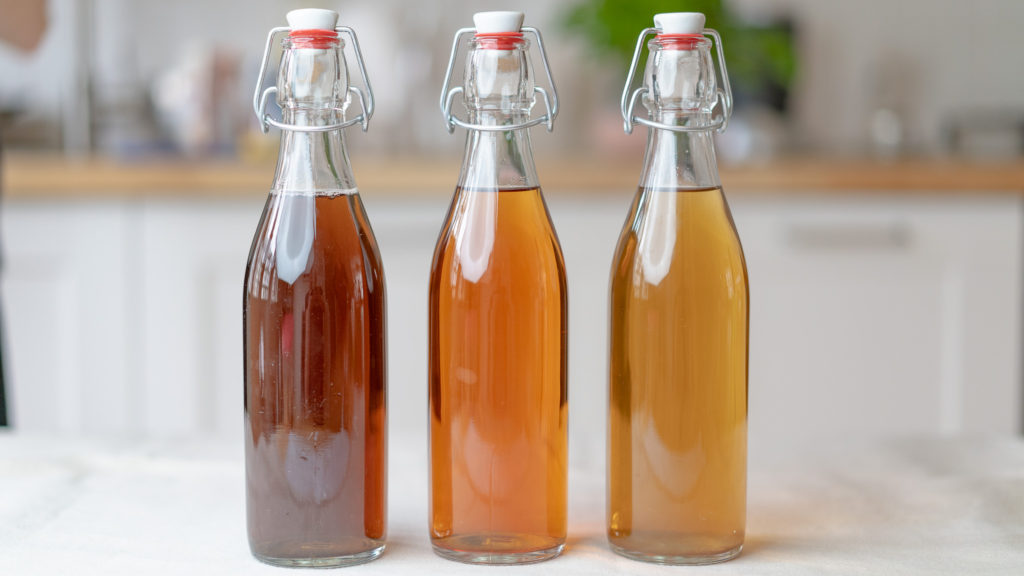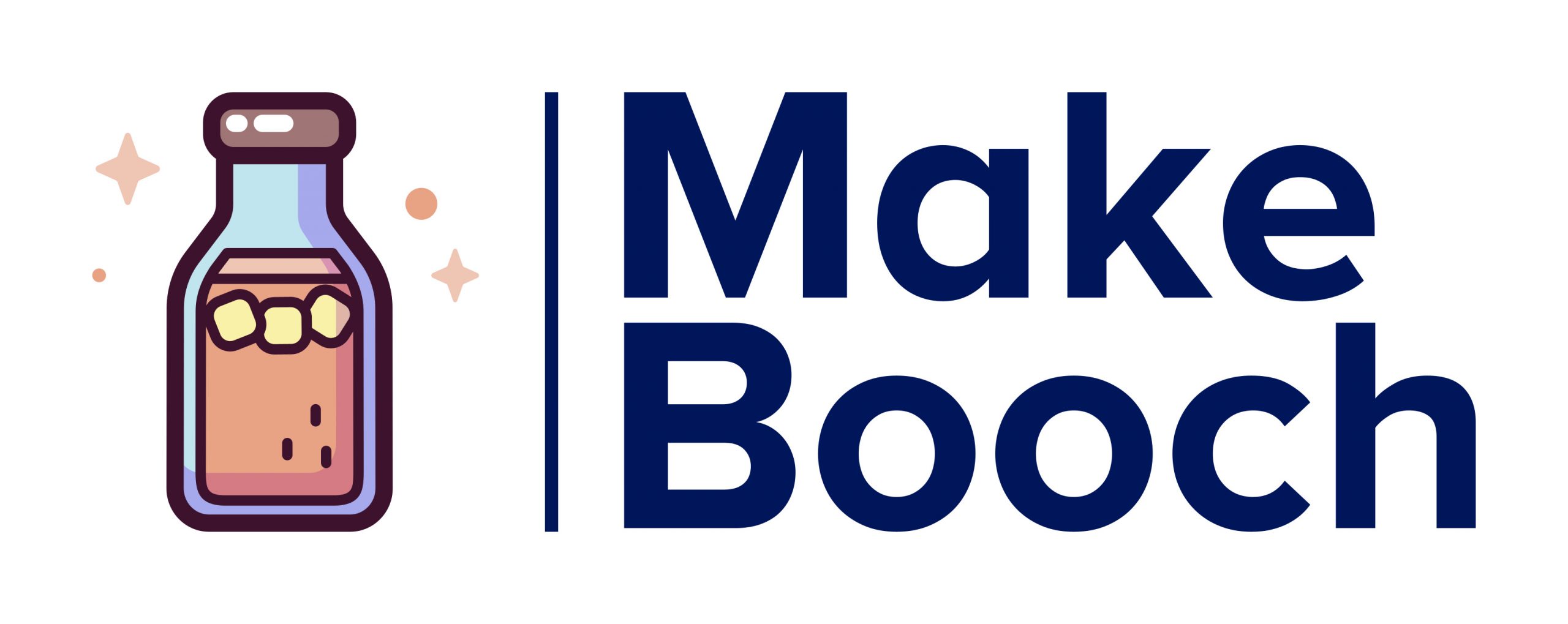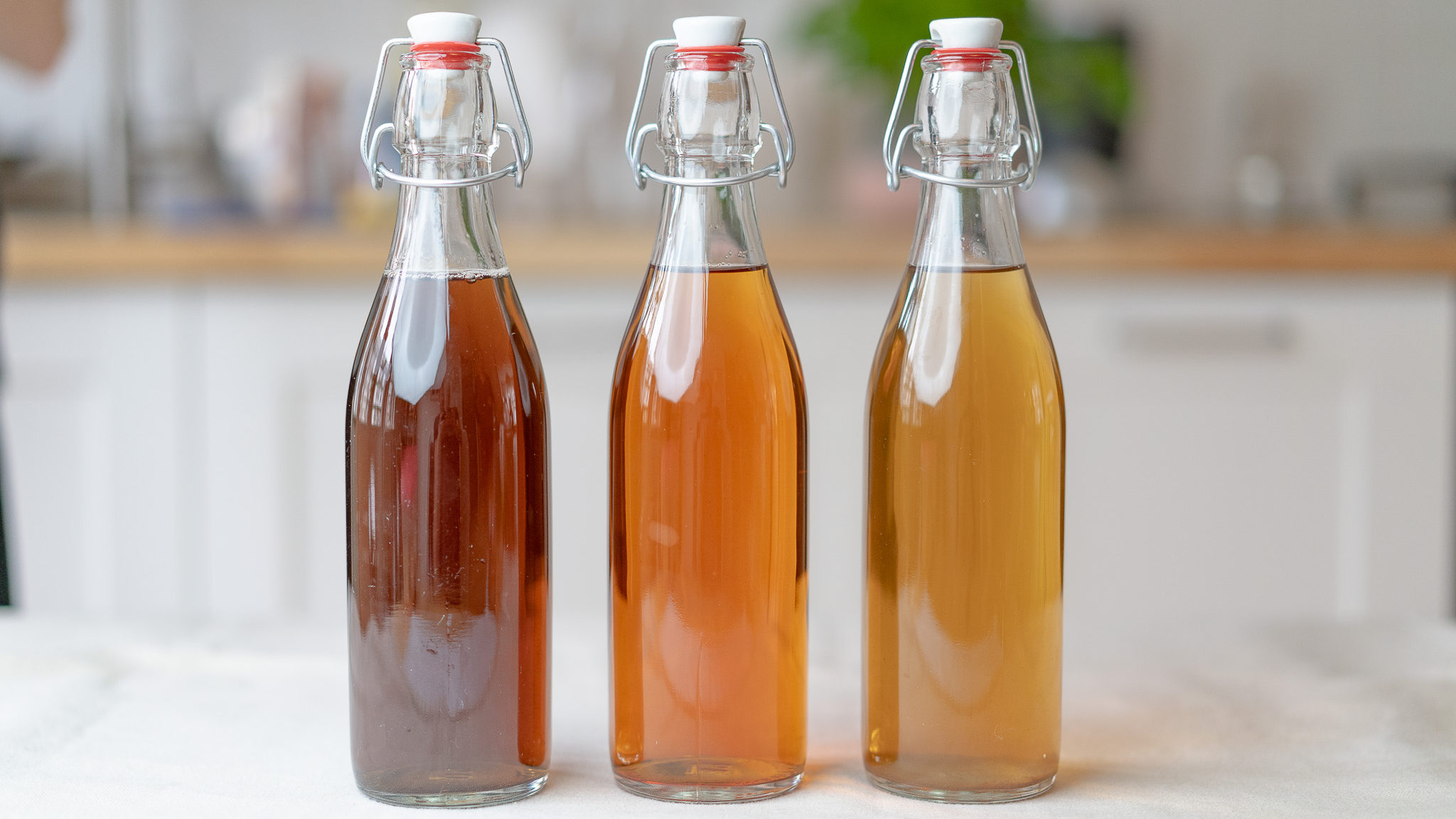When Is Kombucha Ready To Bottle – How to Make Kombucha – Part 2 of 3
You recently started your first fermentation (F1) and you are already anxious for your batch to be ready!You probably have the following question: When is kombucha ready to bottle? This guide will walk you through how to tell when it’s ready for the second fermentation (F2).
If you haven’t started your batch of kombucha yet, check out our guide to first fermentation before you move on.
This article belongs to our 3-part series on how to make kombucha at home.
Page Contents
What is the second fermentation?
When we refer to bottling your kombucha, we are talking about the second fermentation (F2) that kombucha can undergo.
During this phase, you typically add flavor and carbonation to your brew by putting the kombucha in bottles or other sealed containers with fruits, juices, herbs, or other flavoring ingredients.
The yeasts then undergo a second fermentation, eating up the newly added sugars and converting that into carbon dioxide. This is what gives kombucha that naturally created fizz (or effervescence) that it’s known for!
When is your kombucha done with the first fermentation?

All over the internet, you will find advice telling you to wait anywhere from 6 to 30 days for the first fermentation.
Wow! From one week to one month… that’s a lot of time. How are you supposed to decide when to bottle?
It all comes down to is tasting your brew and making a decision off of what you like.
Really. Some people prefer a sweeter profile, while others like a more sour beverage.
Tip: We like to bottle our kombucha when it has a good amount of tartness and acidity but still maintains a bit of sweetness, maybe even more than we want in our final bottle. This is because the kombucha will continue to ferment after bottling, slowly getting more sour with time!
Our first fermentations are usually 7-10 days long.
We find that kombucha needs at least a week to ferment before it’s reached its ideal flavor profile. That being said, every brew is different and depends on many variables (discussed below).
The longer the kombucha ferments, the sharper, tangier, and more acidic it becomes.
A brew that tastes too sweet may need more time. A brew that is too sour should be bottled immediately and paired with very sweet fruit during F2 to balance out the tang.
How and when should you taste your brew?
We recommend waiting at least 5 days before tasting your brew.
This gives enough time to ensure that a baby SCOBY has completely formed on the top of the batch and that you won’t disrupt its growth.
Use a clean straw, wine thief, or ladle to gently push past the SCOBY and scoop up some of the liquid.
Other indicators that your kombucha is ready for F2:
Smell:
A good sign that your kombucha is ready to be bottled is when it smells tangy and similar to vinegar. Some people describe this as a “sharp” smell.
Color:
Kombucha gets lighter and cloudier over time.
This is because of the bacteria consuming the tannins in the tea, one of the substances credited for giving tea its dark color. The yeast is also reproducing and making the liquid murkier. If your batch is still dark and clear, you should wait more time before bottling.
pH Level:
Kombucha is a very acidic beverage, which contributes to its many health benefits and its ability to fend off mold fairly well during fermentation!
When ready, kombucha is typically between 2.5-3.5 on the pH scale.
However, we do not recommend only measuring the pH of your brew to decide if it’s ready.
Even kombucha with a “proper” pH may be too sweet or too sour. You must taste your batch to know for sure! The pH level can not tell you when your brew is done fermenting.
Variables that affect the overall brew time
Is your brew taking a long time during its first fermentation? Maybe it’s happening really fast? Here are four more factors that influence the speed of F1 and how long it takes your brew to be ready for bottling.
Temperature
Temperatures during fermentation should be within the 20-30ºC range (68-86ºF), ideally within 24-28ºC (75-84ºF).
If it’s too cold, the SCOBY goes into dormancy and stops functioning.
If its too hot, you risk killing the SCOBY.
The hotter the temperature of the liquid, the faster the fermentation goes! If your brew takes too long to reach the level of “done” that you like, try brewing your kombucha in a warmer environment.
SCOBY and Starter Tea
Make sure to use a healthy SCOBY and starter tea that is already very acidic. These two things help jumpstart the brew with bacteria and yeast that the fermentation process needs. They also help protect the batch from mold by quickly acidifying the liquid.
Size of the Brew Vessel
The size of the jar you brew your kombucha in also makes a difference!
If you ferment in a vessel that is wider than it is tall, there is more surface area than depth. The brew will consequently ferment faster. If you use a tall vessel with a skinnier mouth, the fermentation process will be prolonged. Give it up for physics!
As we recommended before, it’s best to stick with a 1-gallon glass jar if you’re a beginner. It’s the preferred choice of most homebrewers.
Ingredients
Did you add enough sugar?
If the brew is taking too long, it might be because you didn’t add enough sugar for the yeast to feed on. Or perhaps you need to steep more tea or for a longer amount of time to provide more nutrients for the bacteria to do their thing!
If you followed our recipe for the first fermentation, everything should be going smoothly.
Are you ready to bottle?
Next: How to Make Kombucha (Part 3 of 3) – Second Fermentation.

